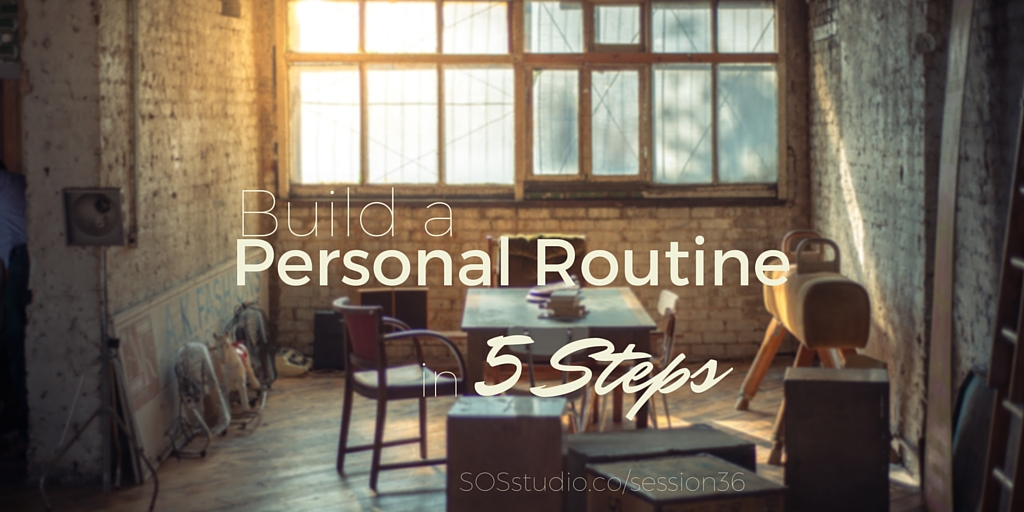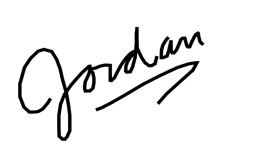
[powerpress]
No one’s life is ideal for setting up a routine. We all have roadblocks that will kick us off the path and prevent us from getting back on. Here’s a quick look (and a personal challenge) at why a personal ritual needs to be simple, why it needs to be repeatable, and why it will affect not only you but those around you.
Tweet This:
I'm terrible at routines. But if Mr. Rogers can do it, so can I! Challenge accepted! Click To Tweet
Follow Along:
-
Not one person’s life is ideal for setting up a routine. There will always be that roadblock that, big or small, makes us divert from our path. And it is in our nature to get distracted while we are off the path and have a hell of a time finding our way back. Or, even worse, to anticipate the roadblock and use that as an excuse to never even start traveling down that path in the first place. So everybody goes through it. But I will tell you, those who keep a routine and stick with it, despite those small or even monstrous diversions are those who achieve their goals faster and reach a higher level of success.
-
Over the course of 31 years, Fred Rogers recorded 865 shows of Mr. Rogers’ Neighborhood. Out of those 865 shows, he performed the exact same routine 865 times:
- He’d walk through the door
- He’d take off his jacket and put on his sweater
- He’d sit down to take off his shoes
- And he’d put on sneakers
-
This was a routine that prepared him for his time to make believe. He was setting a precedent for all of his young fans that structuring one’s day will lead to better creativity and self-improvement; that building a framework allows for one to effortlessly flow between work time and play time.
-
Mr. Rogers once visited Koko, the female gorilla who communicates through American Sign Language. She was such a fan of his show that when she first met him she held him in her lap, signed “I Love You” and started taking off his shoes. His simple gesture of repeating a ritual had resonated so profoundly with her that she had associated it with the entirety of his character. His actions were no longer personal rituals, they were now visual calling cards that embedded his beliefs in the mind of his viewers.
Here are 5 Key Components You May Incorporate Into Your Routine
-
- PLAN AHEAD – Block out chunks of your day for when you want to work, create, play, whatever it is that you need help setting a routine for and be consistent about it. If you have 3 hours free every Tuesday afternoon, put that down in whatever calendar you use weeks, months, or even years ahead so that there is no last-minute attempt to plan (or forget) time to be productive.
- BE SIMPLE – Don’t just go sit down and plan a whole process on paper. Instead, think about what you do normally to prepare yourself for work or creative time and then simplify that into a repeatable pattern. For instance, if you’re not already planning to play racquetball for an hour every morning, don’t add it in now because that will set you back a step in establishing your routine. Start with what you have, simplify it, then plan ahead to adjust your routine using your calendar. You can always adjust your routine moving forward but you’re more likely to accept it if you simply adapt what you’re already doing.
- USE VISUAL CUES – Provide visual cues for yourself such as setting out your notepad and water bottle in the same place every time, or adjusting the lighting in your room, or always sitting in the same chair to work. Plus, the more visual cues you establish, the easier it is to visualize doing it. And what I mean by that is if you think “I need to work on my demo reel” then it’s just a task. But if you can picture sitting on the purple chair in the corner of your room with a cup of tea in your favorite mug and your laptop, just like you do every time you sit down to work on your website, you now have a visualized spot where you can place yourself to get excited about jumping into your work.
- ADD AUDIO CUES – I found a playlist that I like and I turn it on in my headphones whenever I sit down to work. Now, as soon as I turn on the music, I become mentally focused and my brain seams to flow better. I don’t have outside distractions and all of my energy goes into the task at hand. My choice? The Secret Life of Walter Mitty.
- PHYSICAL REMINDERS – Physical actions are the fastest way for your body to remember something. “Muscle memory” is not just a term that actors and hippies use, it is a phenomenon that allows your body to recall prior circumstances when placed in similar positions. With Mr. Rogers, he always opened the closet to get his sweater, and always sat down to put on his shoes. Those are physical actions that don’t have to be in his ritual but are there to provide more cues to his body (and thus mind) that he is getting ready to work.
- For example: Have a routine planned for tomorrow at 8 AM to sit down and write lyrics. The night before, you set out a water bottle, a pad for lyrics, and a pen on the piano. Before you go to sleep you visualize waking up refreshed and starting your morning focused and excited to be at your piano. Start your routine with a 2-minute plank every time, breathing through your nose. This will engage your core, fire up your brain, and tell your body it’s time to be productive. Plug in your headphones and listen to your productivity playlist whenever you’re not actively writing music. This will keep you focused and in the zone.
CHALLENGE
Set a basic framework for when you’re going to schedule your time. If you only have 1 free moment of the day, we’re going to figure out when it should be and what you should use it for. First, ask yourself these questions:
- What time of day do you have control over? When it’s your time and you can structure it how you please…
- What are you looking to get out of your routine? a) Planning your day and getting a step ahead on your personal projects before life hits or b) relaxing into your projects and using them to soothe your tired mind after a long day?
- Where do you want your time? If it’s currently in the morning, would you rather have it at night for decompressing? If it’s currently at night, would you rather use it in the morning to fuel your day?
Now, based on your responses, choose 1 of these challenges:
The Morning Routine
-
Whether or not you’re a morning person, it has great potential to be your most productive time of the day because your body is rested, your mind is clear, and other distractions are still sleeping. Perfect for planning out the rest of your day,
Challenge: For 1 week, set your alarm for 20 minutes before you need to wake up. Dedicate 10 minutes to waking up: read a brain-stimulating chapter in a book, plank and stretch, take a shower, etc… Then dedicate 10 minutes to the first project that comes to mind. Whatever pops up first is probably what you feel most stressed about. Tackle it. This week will earn you 70 additional minutes to work in a time when you’re most focused. Not to mention the rest of your day will now be super energized because of your early commitment. You’re gonna crush it.
Tips:
- Keep your alarm in the bathroom so you can immediately get out of bed, brush your teeth, and splash water on your face. Instant wake up.
- Even light exercise is better than no exercise. Get your blood flowing and your brain will thank you. 30 jumping jacks or a 2 minute plank will be plenty.
- Drink a full glass of water. You just slept for 6-8 hours, you’re dehydrated.
- Be more efficient by getting your mind ready for work the night before. Think about you’re going to wake up and immediately feel energized. Have everything all laid out in advance so you don’t have to do any extra prep work in the morning, eating up your precious 20 minutes. This goes back to the visual cues. Trust me, they work.
The Evening Wind-Down
-
-
If your evenings are your my time, you can de-clutter your brain by getting some of your projects out of the way so that you wake up focused and ready to meet the next day. If you’re tired from working all day, this doesn’t need to be super goal-oriented work, it can allow for more personal quality time, such as scrapbooking. (Thanks to my wife for the good suggestion!)
Challenge: For 1 week, dedicate 20 minutes just before bed to my time. At the end of your day, but before your bedtime routine, set aside 20 minutes free of distractions: no TV or other devices, no spouse (unless they’re working with you), certainly no kids. Find tasks that simultaneously calm you as well as propel your goals forward such as finishing that song or creating a vision board.
Tips:
- This time is more about purging than building. Working yourself into a frenzy over getting something done in 20 minutes won’t be beneficial. In a week, you’ll have dedicated 140 minutes (nearly 2 1/2 hours) to your project. It’ll happen. Stay calm and enjoy it.
- Don’t fuss around after. After your my time, you go straight to bed or the shower or your night time routine. Anything else left around the house will still be there and you’ll be able to get to it tomorrow, after you’ve benefited from your relaxing evening.
- If you’re working on a project that requires you to spread out (scrapbooking or songwriting for example) put away everything after but in a place that’s convenient. Keep it sacred but easily accessible.
- Drink some tea or something calming while you work. Soothe the brain and allow it to melt into focusing on your project.
-
Do You Accept?
I accept the 5-Step Personal Routine challenge. Mornings will be mine! Click To Tweet
I accept the 5-Step Personal Routine challenge. Taking my nights back! Click To Tweet
Links:
Thanks for Listening!
Thank you so much for tuning in to my conversation about harnessing your personal routine!
If you enjoyed this episode, please share it using the social media buttons you see at the bottom of the post.
Also, please leave an honest review for SOSstudio Session on iTunes! Ratings and reviews are extremely helpful and greatly appreciated! They do matter in the rankings of the show, and I read each and every one of them.
And finally, don’t forget to subscribe to the show on iTunes to get automatic updates, or visit our podcast download page! It’s free!
Thanks again for joining! Until next time!

